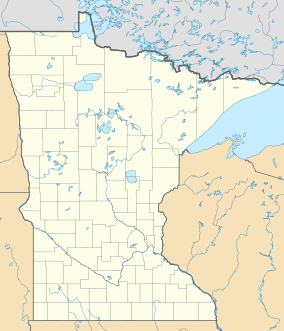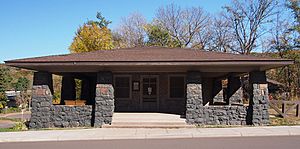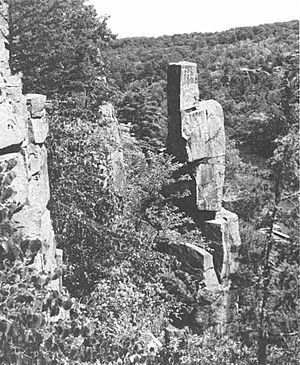Interstate Park facts for kids
|
Interstate State Park WPA/Rustic Style Historic District
|
|
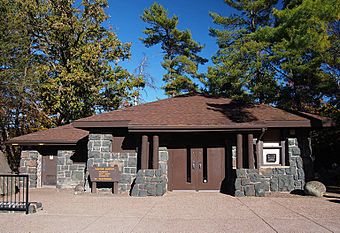
1939 Refectory built by the WPA, now the Minnesota park's visitor center
|
|
| Location | Off U.S. Hwy. 8, Shafer Township |
|---|---|
| Nearest city | Taylors Falls, Minnesota |
| Area | 6 acres (2.4 ha) |
| Built | c. 1920–1939 |
| Architectural style | National Park Service rustic |
| MPS | Minnesota State Park CCC/WPA/Rustic Style MPS |
| NRHP reference No. | 89001664 |
| Added to NRHP | June 11, 1992 |
|
Interstate State Park CCC/WPA/Rustic Style Campground
|
|
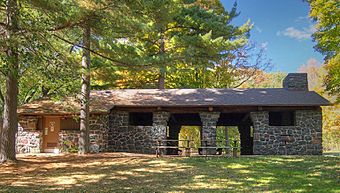
1938 Shelter/Refectory built by the WPA
|
|
| Location | Off US 8 SW of Taylors Falls, Shafer Township |
|---|---|
| Nearest city | Taylors Falls, Minnesota |
| Area | 22 acres (8.9 ha) |
| Built | 1938, 1941 |
| Architectural style | National Park Service rustic |
| MPS | Minnesota State Park CCC/WPA/Rustic Style MPS |
| NRHP reference No. | 92000638 |
| Added to NRHP | June 11, 1992 |
Interstate Park is actually two state parks right next to each other. They are located on the border between Minnesota and Wisconsin. Both parks are called Interstate State Park. They are famous for a deep gorge called the Dalles of the St. Croix River. This gorge has cool rock formations and giant holes in the rocks called glacial potholes.
The Wisconsin park is about 1,330 acres (538 ha) big, and the Minnesota park is about 298 acres (121 ha). The towns of Taylors Falls, Minnesota and St. Croix Falls, Wisconsin are right next to the park. Interstate Park is part of the Saint Croix National Scenic Riverway and the Ice Age National Scientific Reserve. The start of the Ice Age National Scenic Trail is on the Wisconsin side. On the Minnesota side, some old buildings and structures built in a special "rustic" style are listed on the National Register of Historic Places.
Contents
Exploring the Park's Geology
Interstate Park shows rocks and dirt from three different time periods in Earth's history. These periods are the Precambrian, Paleozoic, and Cenozoic eras.
Ancient Volcanic Rocks: Precambrian Era
The oldest rocks are from about 1.1 billion years ago. They are made of basaltic lava flows and other rocks that filled an ancient rift valley. This valley was part of the Midcontinent Rift System, a huge crack in the Earth's crust. Imagine lava pouring out and filling a giant ditch over millions of years!
Shallow Seas and Sandstone: Paleozoic Era
Between 530 and 470 million years ago, during the Cambrian period, this area was covered by a shallow sea. This sea left behind layers of sandstone and siltstone on top of the older volcanic rocks. These layers help scientists understand what the Earth was like back then.
Ice Ages and River Formation: Cenozoic Era
The most recent changes happened during the Ice Ages (Pleistocene Epoch). Giant sheets of ice, called the Laurentide Ice Sheet, covered this area many times. These glaciers left behind different types of dirt and rocks.
How the St. Croix River Gorge Formed
The glaciers melted between 19,000 and 14,000 years ago. As the ice melted, huge amounts of meltwater flowed from giant proglacial lakes, like Lake Duluth. This powerful water carved out the deep gorge of the St. Croix River. The water also created the famous potholes you can see today.
Discovering Glacial Potholes
The potholes started when sand and gravel got caught in whirlpools in the rushing meltwater. These swirling rocks drilled holes straight down into the hard rock. Bigger rocks would polish the sides of these holes, making them smooth.
The Glacial Gardens area on the Minnesota side has over 80 of these glacial potholes. It's one of the largest collections in the world! One famous pothole, called the Bottomless Pit, is 10 feet (3.0 m) wide and 60 feet (18 m) deep. It's the deepest explored pothole in the world. Some other potholes in the park are even wider, so they might be even deeper!
Unique Rock Formations
Besides potholes, the park has other cool rock formations shaped by nature. The Old Man of the Dalles on the Wisconsin side looks like a human face. There was also a formation on the Minnesota side called the Devil's Chair, which looked like a tall throne.
Exploring the Park's Biology
Interstate Park is home to many different kinds of plants and animals.
Plant Life and Habitats
Most of the park was once covered with huge eastern white pine trees. However, these were cut down by loggers a long time ago. Today, most of the trees are second-growth forests. Some areas have maples and basswood trees, while others have eastern white pines.
Drier spots have oak savannas, which are like grasslands with scattered oak trees. Wetter areas near the river have floodplain forests. You can even find the brittle prickly pear cactus on the driest hilltops. This is the only cactus that grows naturally in Wisconsin! Over 400 types of ferns and flowering plants have been found in the Wisconsin park.
Animal Life
Many Mammals live in the parks, including white-tailed deer, foxes, raccoons, gray squirrels, river otters, minks, skunks, muskrats, and beavers. About 150 different kinds of birds have been seen in the park, and at least 75 of them build their nests there.
A Look at the Park's Cultural History
The St. Croix River was an important path for Native Americans long ago. Tools from prehistoric times have been found in the park. Later, Fur traders used the river a lot, and a French fort was located near the Minnesota campground in the early 1700s.
The Logging Era and Log Jams
From 1837 to 1898, the river was used to float huge numbers of logs downstream during the logging era. The narrow gorge and a sharp turn at Angle Rock often caused massive logjams. The 1886 St. Croix River log jam was one of the worst in history. About 150 million board feet of logs were stuck for three miles (4.8 km)! It took 175 men working day and night for six weeks to clear it. To prevent future jams, the Nevers Dam was built upstream in 1890.
During this time, the Dalles became a popular place to visit. Steamboats started bringing tourists in 1838, and a railroad connection was built in 1880. People even came to see the huge log jams!
How Interstate Park Was Created
In the 1860s, some business people wanted to mine the basalt rock from the Dalles for gravel. This idea made people realize they needed to protect the area. A travel agent named George Hazzard led the effort to create a park. He got support from newspapers, landowners, and important people like W.H.C. Folsom.
In 1895, a bill passed in Minnesota, creating the second state park in Minnesota. It also encouraged cooperation with Wisconsin to protect both sides of the Dalles. It was harder to convince Wisconsin, but they finally created their first state park in 1900. This made Interstate Park the first parkland collaboration between two states in the United States!
Since 1906, a family from Stillwater, Minnesota, has been offering boat tours of the Dalles. They started with a small powerboat and now offer tours on larger boats, plus canoe and kayak rentals. This business is still family-owned, four generations later!
New Deal Improvements to the Park
In the 1930s, many improvements were made to the park. U.S. Route 8 was built through the Minnesota park in 1931. The Minnesota Department of Transportation added stone overlooks and guardrails along the highway.
The Civilian Conservation Corps (CCC) arrived in 1935. These workers built roads, trails, picnic areas, and even the beach and beach house on Lake O' the Dalles. After the CCC left, the Works Progress Administration (WPA) took over in 1938. They used basalt rock from the park to build restrooms, picnic shelters, and water fountains.
These historic structures are found in two areas of the Minnesota park: the campground and near the Glacial Gardens. These areas are now listed as historic districts on the National Register of Historic Places. They show how federal work programs helped develop state parks and used a special "rustic" design style.
The Interstate State Park CCC/WPA/Rustic Style Historic District is about 6-acre (2.4 ha) and has six important historical features. These include two old restrooms built around 1920 and 1928, which influenced later designs. The 1939 Refectory building, which was once a snack bar, is now the park's visitor center. There are also stone curbs, a retaining wall, and a water fountain from the 1930s.
The Interstate State Park CCC/WPA/Rustic Style Campground is about 22-acre (8.9 ha) and also has six important historical features. These include the 1938 Sanitation Building (restrooms), the 1938 Shelter/Refectory (a picnic shelter), and the 1941 Combination Building (more restrooms in the campground). There are also three drinking fountains from 1938.
The Devil's Chair Vandalism
In April 2005, a famous rock formation called the Devil's Chair collapsed. An investigation showed that vandals used tools like crowbars to knock it over. Even though there was a reward, the people who did it were never found.
Fun Activities at Interstate Park
Interstate Park is only about an hour's drive from Minneapolis–Saint Paul. Many people visit it every year, similar to how many visit some U.S. national parks.
The two parks are managed separately, so you usually need a different vehicle permit for each state's park. However, you can easily walk between the parks by crossing the U.S. Route 8 bridge. Both parks have a visitor center where you can learn more and buy souvenirs.
The Wisconsin park has two campgrounds with 85 campsites. There's also a group campsite for up to 60 people. You can explore about 9 miles (14 km) of trails there.
The Minnesota park has a campground with showers and 37 campsites, and 22 of them have electricity. There's a group campsite for up to 100 people. This park has about 4 miles (6.4 km) of trails. You can also take scenic boat cruises or rent canoes and kayaks.
There's a swimming beach on Lake O' the Dalles in the Wisconsin park. Swimming in the river can be dangerous because of strong currents. Rock climbing is allowed on many of the cliffs on both sides of the river. However, some sensitive areas and all the potholes are off-limits for climbing.
Images for kids



